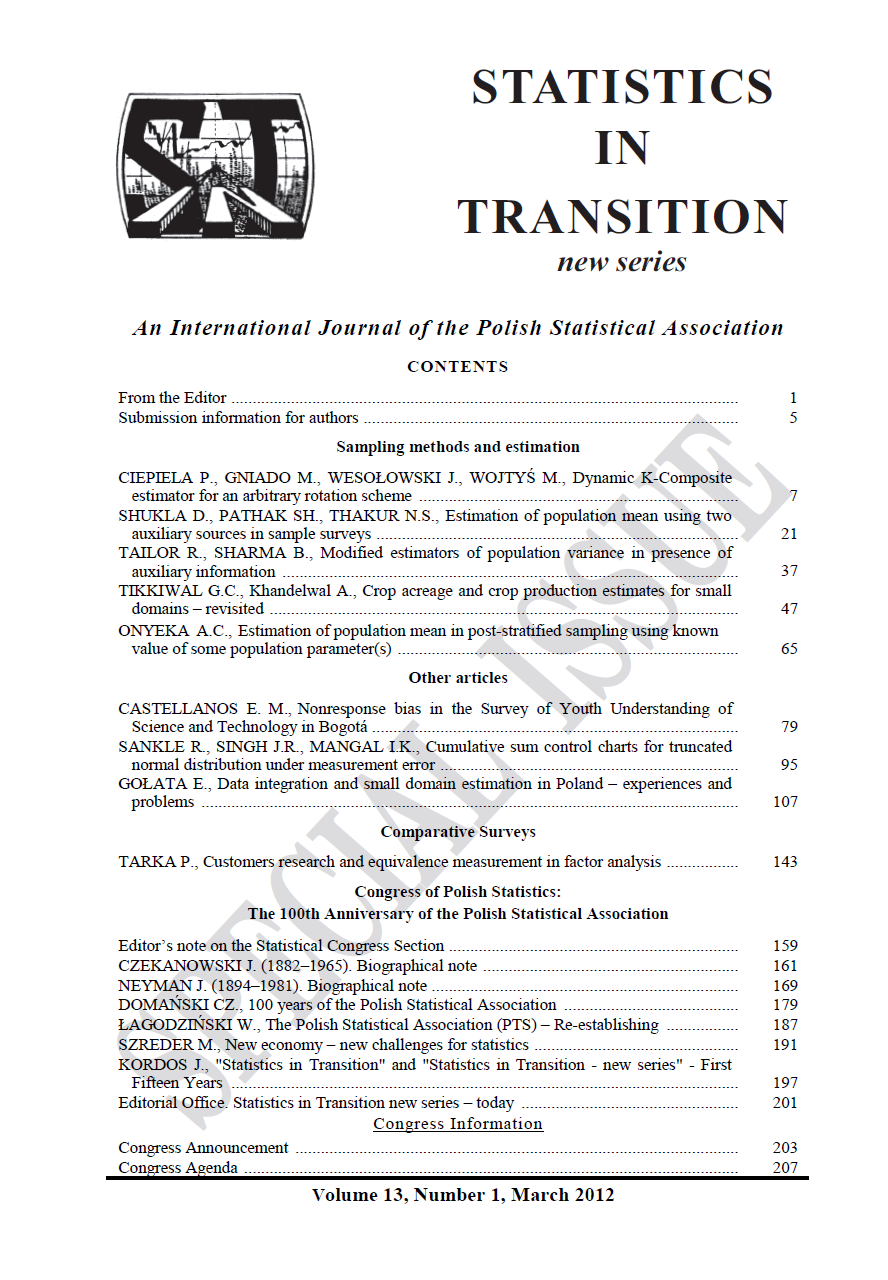ARTICLE
ABSTRACT
Classical K-composite estimator was proposed in Hansen et al. (1955). Its optimality properties were developed in Rao and Graham (1964). This estimator gives an alternative solution to quasi-optimal estimation under rotation sampling when it is allowed that units leave the sample for several occasions and then come back. Such situations happen frequently in real surveys and are not covered by the recursive optimal estimator introduced by Patterson (1955). However the K-composite estimator suffers from certain disadvantages. It is designed for a stable situation in the sense that its basic parameter is kept constant on all occasions. Additionally it is restricted only to a certain family of rotation designs. Here we propose a dynamic version of the K-composite estimator (DK-composite estimator) without any restrictions on the rotation pattern. Mathematically, the algorithm, we develop, is much simpler than the one for the classical K-composite estimator with optimal weights. Moreover, it is precise, in the sense that it does not use any approximate or asymptotic approach (opposed to the method used in Rao and Graham (1964) for computing optimal weights).
REFERENCES
BAILAR, B. (1975). The effects of rotation group bias on estimates from panel surveys. J. Amer. Statist. Assoc. 70, 23-30.
BELL, P. (2001). Comparison of alternative Labour Force Survey estimators.Survey Meth. 27(1), 53-63.
BREAU, P., ERNST, L. (1983). Alternative estimators to the current com posite estimator. Proc. Sec. Survey Res. Meth., Amer. Statist. Assoc.,397-402.
CANTWELL, P.J. (1988). Variance formulae for the generalized composite estimator under balanced one-level rotation plan. SRD Research Report Census/SRD/88/26, Bureau of the Census, Statistical Research Division,1-16.
CANTWELL, P.J., CALDWELL, C.V. (1998). Examining the revisions in monthly retail and wholesale trade surveys under a rotation panel design.J. Offic. Statist. 14, 47-54.
Current Population Survey (2002). Design and Methodology, Technical Paper 63RV, Bureau of Labour Statistics, U.S. Census Bureau.
FULLER, W., RAO, J.N.K. (2001). A regression composite estimator with application to the Canadian Labour Force Survey. Survey Meth. 27(1),45-51.
GURNEY, M., DALY, J.F. (1965). A multivariate approach to estimation in periodic sample surveys. Proc. Amer. Statist. Assoc., Sect. Soc. Sta tist., 242-257.
HANSEN, M.H., HURWITZ, W.N., NISSELSON, H., STEINBERG, J.(1955). The redesign of the census current population survey. J. Amer.Math. Assoc. 50, 701-719.
KOWALSKI, J. (2009). Optimal estimation in rotation patterns. J. Statist.Plan. Infer. 139(4), 2429-2436.
LENT, J., MILLER, S., CANTWELL, P. (1994). Composite weights for the Current Population Survey. Proc. Sec. Survey Res. Meth., Amer. Sta tist. Assoc., 867-872.
MCLAREN, C.H., STEEL, D.G. (2000). The impact of different rotation patterns on the sampling variance of seasonally adjusted and trend esti mates. Survey Meth. 26(2), 163-172.
PATTERSON, H.D. (1950). Sampling on successive occasions with partial replacement of units. J. Royal Statist. Soc., Ser. B 12, 241-255.
POPIŃSKI, W. (2006). Development of the Polish Labour Force Survey.Statist. Transit. 7(5), 1009-1030.
RAO, J.N.K., GRAHAM, J.E. (1964). Rotation designs for sampling on repeated occasions. Ann. Math. Statist. 35, 492-509.
SINGH, A.C. (1996). Combining information in survey sampling by modified regression. Proc. Sect. Survey Res. Meth., Amer. Statist. Assoc.,120-129.
SINGH, A.C., KENNEDY, B., WU, S. (2001). Regression composite esti mation for the Canadian Labour Force Survey with a rotating panel design. Survey Meth. 27, 33-44.
STEEL, D., MCLAREN, C. (2002), In search of a good rotation pattern. In:Advances in Statistics, Combinatorics and Related Areas. Singapore,World Scientific, 309-319.
STEEL, D., MCLAREN, C. (2008). Design and analysis of repeated surveys.Centre for Statist. Survey Meth., Univ. Wollonong, Working Paper 11-08,1-13, http://ro.uow.edu.au/cssmwp/10
SZARKOWSKI, A., WITKOWSKI, J. (1994), The Polish labour force survey.Statist. Transit. 1(4), 467-483.
TOWHIDI, M., NAMAZI-RAD, M.-R. (2010). An optimal method of esti mation in rotation sampling. Adv. Appl. Statist. 15(2) , 115-136.
WESOŁOWSKI, J. (2010). Recursive optimal estimation in Szarkowski ro tation scheme. Statist. Transit. 11(2), 267-285.
YANSANEH, I.S., FULLER, W. (1998). Optimal recursive estimation for repeated surveys. Survey Meth. 24, 31-40
